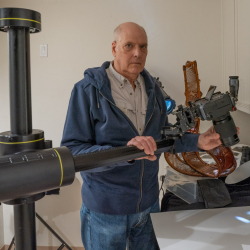Home > Topics > Site and Board Matters > New Article Announcements & Discussions > Basic Color
Basic Color
-
AuthorTopic: Basic Color Read 30798 Times
-
Basic Coloron: May 4, 2020 at 3:13 pm
I’m glad that you and Jim are discussing soft proofing vs. hard proofing. Certainly both of you have excellent points. Nevertheless after spending lots of time using a viewing box and calibrating my monitor using various reference images, printing, and saving profiles for various papers, I have reached the same conclusion: For prints that are to the best possible standards hard proofing is indispensable
With reference to hard proofing: Do you find the printed image proofed on a monitor profile with for example D50 light will look materially different when that particular print is viewed in different “colored” light? Another way of asking the same question: Do you proof differently depending upon the conditions in which the print might be viewed? It would seem onerous ( unless one is using Image Print ) to have profiles for all possible lighting conditions.
I think your first paragraph is one of these “in the eye of the beholder” issues, so while I respect your view of the matter, it doesn’t reflect my experience. I seldom need to reprint a photo because of unexpected results, I have been doing this with digital processes for two decades and I’m fussy about what I want for both tone and colour in my prints.
Your second paragraph is really tricky to deal with. Because of our visual adaptation, the longer we wait between viewing under either one condition or the other, the less apparent the differences will be because our eyes adapt to what is in front of us and we quickly forget what came before. But if we were to do a quick back and forth between say D50 and D65, the difference would be immediately apparent and we may well be tempted to make adjustments for the one we expect to be the most relevant viewing condition. And the nice thing about display 6 is that it allows us to do exactly that just by clicking a button.
Re: Basic ColorReply #1 on: May 4, 2020 at 3:58 pmAll good points. Your experience in printing images for many years supplies excellent insights Mark…the voice of experience is usually well tuned!
Thanks.
Re: Basic ColorReply #2 on: May 4, 2020 at 4:09 pmYou are welcome Eliot.
Re: Basic ColorReply #3 on: May 4, 2020 at 4:33 pmI seldom need to reprint a photo because of unexpected results,
I find that all of the following affect my print-time choices for exhibition prints:
- Size of the print
- Surface finish of the paper
- Gamut of the paper (that can be soft proofed)
- Size of the mat
- Color of the mat
- Illumination level at the print
- Overall illumination level in the gallery
- Illumination spectrum
- Color of the walls
Most of those are hard to simulate using soft-proofing. Certainly, when you soft-proof you’re working with metameric matches, which have their limitations. Except for those, it should be possible, with the right equipment, to simulate the entire exhibition space, but it would be a very expensive setup (maybe VR will get to the point where it can be used for that). I find that the most advanced exhibition spaces tend to be the hardest to print for, since the illumination levels are generally so low.
That said, soft proofing gets you in the ballpark, and that’s worth a lot.
Jim
Re: Basic ColorReply #4 on: May 4, 2020 at 4:37 pmFair enough, I wasn’t responding with those added exhibition conditions in mind. I have in mind a much simpler set-up which consists of one known viewing condition of an unframed, non-matted print. Once one starts adding-in those other considerations I can see limitations creeping in.
Re: Basic ColorReply #5 on: May 5, 2020 at 3:35 amWell, I wouldn’t sell soft proofing short. I view it as both a technical process to get the best output possible but also a selection editing tool as well as a critical part of the creative process.
The key to proper use of soft proofing is evaluate an image based on what the image will look like in print. Depending on how good you are at soft proofing (I’m pretty good at it) you can use it to help determine the optimal media to use for a given image…some image require the D-Max of glossy media, some images look better with softer less dense media like matte or watercolor paper.
And, while soft proofing is often though of as color rendering and matching exercise, I view it as a creative process as well. Once you’ve soft proof with the proper profile, you can meet and exceed merely matching the final printed output…you can push the image to manipulate the final rendering.
So, I use soft proofing to check and image before printing but I also use it to evaluate how best to print as well as how best to tweak and modify the image to get the best output and image can give me.
Re: Basic ColorReply #6 on: May 5, 2020 at 9:34 amInteresting how you can use soft proofing to guide your choices of various papers Jeff.
Your workflow and insights would make a great presentation on PhotoPXL.
Elliot
Re: Basic ColorReply #7 on: May 5, 2020 at 10:21 amWell, I wouldn’t sell soft proofing short. I view it as both a technical process to get the best output possible but also a selection editing tool as well as a critical part of the creative process.
The key to proper use of soft proofing is evaluate an image based on what the image will look like in print. Depending on how good you are at soft proofing (I’m pretty good at it) you can use it to help determine the optimal media to use for a given image…some image require the D-Max of glossy media, some images look better with softer less dense media like matte or watercolor paper.
And, while soft proofing is often though of as color rendering and matching exercise, I view it as a creative process as well. Once you’ve soft proof with the proper profile, you can meet and exceed merely matching the final printed output…you can push the image to manipulate the final rendering.
So, I use soft proofing to check and image before printing but I also use it to evaluate how best to print as well as how best to tweak and modify the image to get the best output and image can give me.
I don’t disagree with any of that. I’m saying that, for critical work, although it is undeniably useful, it doesn’t remove the need for hard proofing. That’s when the soft proofing environment is set up properly. Most people don’t set their soft proofing environment up optimally, and that makes their experience more chancy. Typical errors:
- Wrong surround
- Not enough surround
- Insufficient control of viewer’s adaptation
- Wrong luminance
- Uncontrolled viewing angle
- Peaky backlight
Re: Basic ColorReply #8 on: May 5, 2020 at 11:31 amI’m saying that, for critical work, although it is undeniably useful, it doesn’t remove the need for hard proofing. …………. Most people don’t set their soft proofing environment up optimally, and that makes their experience more chancy. Typical errors:
- Wrong surround
- Not enough surround
- Insufficient control of viewer’s adaptation
- Wrong luminance
- Uncontrolled viewing angle
- Peaky backlight
Hi Jim,
Bringing this back to the context of the article, my main point was that a well-calibrated and well profiled display is important to be able to do successful soft-proofing. My criterion for “successful” is very simply that one is not disappointed or surprised by what comes out of the printer after having made all one’s image adjustments being guided by the display. You are correct that some conditions are not amenable to soft-proofing because we don’t have applications that address them, mainly because they are simply hard to replicate. But those conditions are not necessarily relevant to everyone’s requirements. It depends on the purpose. So the need for hard-proofing may or may not be completely mitigated depending on context and purpose. The most relevant aspects of display calibration for successful soft-proofing are gamut, white point, contrast curve and luminance, and all of those are user options in basICColor display 6 Calibration settings, as they are in some other display profiling applications. It is of course up to the user to get these parameters right depending on his/her environment and purposes, and that can require some experimentation; but once one gets the hang of what works best and what doesn’t, a tremendous amount of time, ink and paper waste can be avoided just by relying on the softproof. With NEC and Eizo monitors and this software, one can set-up a number of different calibrations purposed to different viewing conditions and switch between them with a mouse click. This adds flexibility where needed. You mention what “most people” don’t do properly – I don’t know, I like to think that if I can use softproofing successfully, within the bounds of what it can accomplish, so can many other people. Whether they do or not of course is a first-world problem in their hands, and I have no data to know – the important thing is that the developers have made the key tools available to us and they can work well.
Cheers, Mark
Re: Basic ColorReply #9 on: May 5, 2020 at 2:31 pmYou mention what “most people” don’t do properly – I don’t know, I like to think that if I can use softproofing successfully, within the bounds of what it can accomplish, so can many other people. Whether they do or not of course is a first-world problem in their hands, and I have no data to know – the important thing is that the developers have made the key tools available to us and they can work well.
It’s like an onion, with several layers you have to get right. You peel the onion until you get to the point where you’re satisfied. Here’s one reason I think the way I do about the way that “most people” work. When I go to a workshop where the class members are all working at their computers, I notice that almost none of them have the surround properly set. It’s usually way too dark and doesn’t occupy enough visual space.
I’m not taking anything away from calibrating your monitor when you’re printing. It’s important, and it should be done. And it sounds like the software you reviewed does a good job of that.
Jim
Re: Basic ColorReply #10 on: May 5, 2020 at 2:45 pmHi Jim – OK, your workshop experience is a good data point. I guess that’s why they go to workshops – to learn. 🙂
Cheers, Mark
Re: Basic ColorReply #11 on: May 5, 2020 at 3:49 pmWith NEC and Eizo monitors and this software, one can set-up a number of different calibrations purposed to different viewing conditions and switch between them with a mouse click.
And you can do that with their software products (example SpectraView II for the NEC SpectraViews). Now the question becomes, which is more robust and has the most control over the display’s internal hardware?
Author “Color Management for Photographers" & "Photoshop CC Color Management" (pluralsight.com)”
-
This reply was modified 4 years ago by
 Andrew Rodney.
Andrew Rodney.
-
AuthorPosts
- You must be logged in to reply to this topic.






